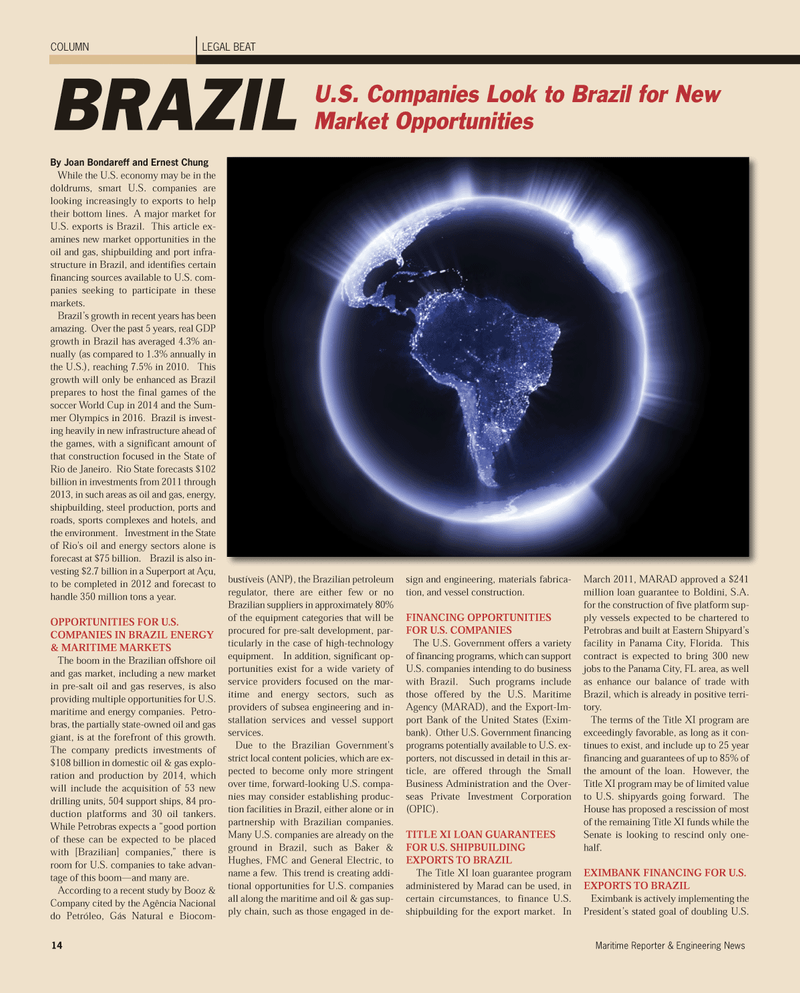
Page 14: of Maritime Reporter Magazine (December 2011)
Great Ships of 2011
Read this page in Pdf, Flash or Html5 edition of December 2011 Maritime Reporter Magazine
14Maritime Reporter & Engineering News By Joan Bondareff and Ernest Chung While the U.S. economy may be in thedoldrums, smart U.S. companies arelooking increasingly to exports to help their bottom lines. A major market for U.S. exports is Brazil. This article ex- amines new market opportunities in the oil and gas, shipbuilding and port infra- structure in Brazil, and identifies certain financing sources available to U.S. com- panies seeking to participate in thesemarkets. Brazil?s growth in recent years has been amazing. Over the past 5 years, real GDP growth in Brazil has averaged 4.3% an- nually (as compared to 1.3% annually inthe U.S.), reaching 7.5% in 2010. This growth will only be enhanced as Brazil prepares to host the final games of the soccer World Cup in 2014 and the Sum- mer Olympics in 2016. Brazil is invest- ing heavily in new infrastructure ahead of the games, with a significant amount of that construction focused in the State ofRio de Janeiro. Rio State forecasts $102billion in investments from 2011 through 2013, in such areas as oil and gas, energy, shipbuilding, steel production, ports and roads, sports complexes and hotels, and the environment. Investment in the State of Rio's oil and energy sectors alone is forecast at $75 billion. Brazil is also in-vesting $2.7 billion in a Superport at Açu, to be completed in 2012 and forecast tohandle 350 million tons a year. OPPORTUNITIES FOR U.S. COMPANIES IN BRAZIL ENERGY& MARITIME MARKETSThe boom in the Brazilian offshore oil and gas market, including a new market in pre-salt oil and gas reserves, is also providing multiple opportunities for U.S. maritime and energy companies. Petro- bras, the partially state-owned oil and gas giant, is at the forefront of this growth. The company predicts investments of $108 billion in domestic oil & gas explo- ration and production by 2014, whichwill include the acquisition of 53 new drilling units, 504 support ships, 84 pro-duction platforms and 30 oil tankers. While Petrobras expects a ?good portion of these can be expected to be placed with [Brazilian] companies,? there is room for U.S. companies to take advan- tage of this boom?and many are. According to a recent study by Booz &Company cited by the Agência Nacional do Petróleo, Gás Natural e Biocom-bustíveis (ANP), the Brazilian petroleum regulator, there are either few or no Brazilian suppliers in approximately 80%of the equipment categories that will be procured for pre-salt development, par- ticularly in the case of high-technologyequipment. In addition, significant op- portunities exist for a wide variety of service providers focused on the mar- itime and energy sectors, such as providers of subsea engineering and in- stallation services and vessel support services.Due to the Brazilian Government's strict local content policies, which are ex- pected to become only more stringentover time, forward-looking U.S. compa- nies may consider establishing produc-tion facilities in Brazil, either alone or in partnership with Brazilian companies.Many U.S. companies are already on the ground in Brazil, such as Baker & Hughes, FMC and General Electric, toname a few. This trend is creating addi- tional opportunities for U.S. companiesall along the maritime and oil & gas sup- ply chain, such as those engaged in de- sign and engineering, materials fabrica- tion, and vessel construction. FINANCING OPPORTUNITIES FOR U.S. COMPANIES The U.S. Government offers a variety of financing programs, which can supportU.S. companies intending to do business with Brazil. Such programs includethose offered by the U.S. Maritime Agency (MARAD), and the Export-Im- port Bank of the United States (Exim-bank). Other U.S. Government financing programs potentially available to U.S. ex- porters, not discussed in detail in this ar- ticle, are offered through the Small Business Administration and the Over- seas Private Investment Corporation (OPIC). TITLE XI LOAN GUARANTEES FOR U.S. SHIPBUILDING EXPORTS TO BRAZIL The Title XI loan guarantee program administered by Marad can be used, incertain circumstances, to finance U.S.shipbuilding for the export market. In March 2011, MARAD approved a $241 million loan guarantee to Boldini, S.A.for the construction of five platform sup- ply vessels expected to be chartered to Petrobras and built at Eastern Shipyard?s facility in Panama City, Florida. This contract is expected to bring 300 new jobs to the Panama City, FL area, as well as enhance our balance of trade withBrazil, which is already in positive terri- tory. The terms of the Title XI program are exceedingly favorable, as long as it con- tinues to exist, and include up to 25 year financing and guarantees of up to 85% of the amount of the loan. However, the Title XI program may be of limited value to U.S. shipyards going forward. The House has proposed a rescission of mostof the remaining Title XI funds while the Senate is looking to rescind only one-half. EXIMBANK FINANCING FOR U.S. EXPORTS TO BRAZIL Eximbank is actively implementing the President?s stated goal of doubling U.S.LEGAL BEAT COLUMNBRAZILU.S. Companies Look to Brazil for NewMarket Opportunities MR Dec.11 # 2 (10-17):MR Template 12/6/2011 9:20 AM Page 14

 13
13

 15
15
